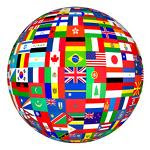The date 2009 IJSBA Parade of Nations is coming upon us quickly. Here is some information that may help you understand the flag ettiquette of your country and others.
Have you ever wondered how national flags are displayed correctly? This article provides a general overview of flag etiquette. It is important to note that the policies, traditions, customs, rules and laws of your country or those of other countries pertaining to flag etiquette may differ from those provided in this article.
Fly the flag from sunrise to sunset on a clear day. National flags should not be flown in bad weather (e.g. during thunderstorms or hailstorms)unless it is an all-weather flag. If a national flag is flown at night it should be brightly illuminated
Hoist (raise) the flag in a brisk fashion and lower it in a dignified, ceremonious way.
Flags flown at half-mast should be hoisted to full mast then lowered slowly and ceremoniously to half-mast.
Never let a national flag touch the ground, water or the floor.
Display a national flag in a position superior to all other flags (such as state or provincial flags) except when flags of other countries are displayed (such as at the United Nations or during the Olympic Games).
Flags of the World When flags of multiple countries are flown in the same place, they must all be displayed as equals. They should each be flown on individual flagpoles each of the same size. All of the flags must be the same size and no flag can be bigger or smaller than another flag. National flags of multiple countries should be arranged in alphabetical order.
When two flags are displayed (in a line); the national flag should appear on the left side when viewed by an observer.
When three flags are displayed in a line the national flag should be in the middle (i.e. the second flag).
When four flags are displayed in a line, the national flag should be the first flag on the left when viewed by an observer.
When five or more flags are displayed in a line, two national flags should appear at both ends of the line (e.g. in a line of five flags, the national flag should appear as the first flag and the fifth flag).
When a flag is no longer in good condition (e.g. if it is torn, ripped or badly soiled) it should not be raised or displayed. It should be disposed of in a dignified way (such as a private burning. See this article for an example of the correct procedure).
Always respect the customs and traditions of different countries regarding their national flags. For example, Saudi Arabia, Sri Lanka and Pakistan have all clearly prohibited their national flags from being displayed vertically (e.g. when hung from a wire or mounted to a wall). Never display the national flags of those countries in a vertical position.
This is a general guide only. Policies, rules, laws, traditions and customs of your country or other countries may differ from the information contained in this article. If in doubt, always consult your government or another official authority about the appropriate display of your country's national flag.
Subscribe to:
Post Comments (Atom)


No comments:
Post a Comment